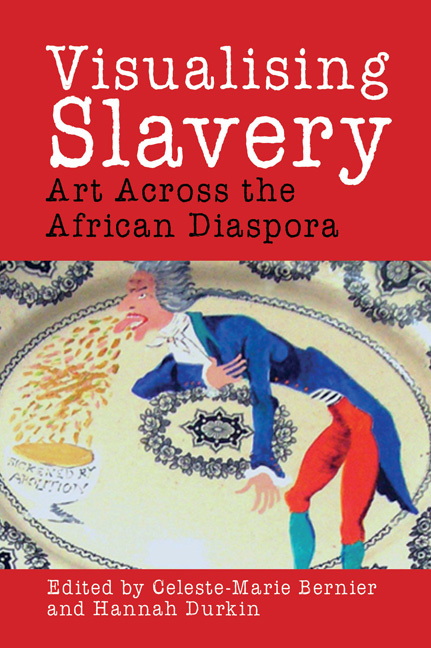Book contents
- Frontmatter
- Dedication
- Contents
- List of Illustrations
- Acknowledgements
- Introduction: ‘Inside the Invisible’: African Diasporic Artists Visualise Transatlantic Slavery
- Part I Slavery and Memory in Contemporary African Diasporic Art
- Part II Historical Iconography and Visualising Transatlantic Slavery
- Part III African Diasporic Monuments and Memorialisation
- Part IV Contemporary Legacies in African Diasporic Art
- Chapter 13 We Might Not Be Surprised: Visualising Slavery and the Slave Ship in the Works of Charles Campbell and Mary Evans
- Chapter 14 ‘X is for X Ray, X Slave, X Colony’: A ‘Lexicon of Liberation’ versus ‘My Slave History’ in the Paintings, Installations and Sketchbooks of Donald Rodney
- Chapter 15 Reconfiguring African Trade Beads: The Most Beautiful, Bountiful and Marginalised Sculptural Legacy to Have Survived the Middle Passage
- Afterword: Against the Grain: Contingency and Found Objects
- Notes on Contributors
- Index
- Platesection
Chapter 15 - Reconfiguring African Trade Beads: The Most Beautiful, Bountiful and Marginalised Sculptural Legacy to Have Survived the Middle Passage
from Part IV - Contemporary Legacies in African Diasporic Art
- Frontmatter
- Dedication
- Contents
- List of Illustrations
- Acknowledgements
- Introduction: ‘Inside the Invisible’: African Diasporic Artists Visualise Transatlantic Slavery
- Part I Slavery and Memory in Contemporary African Diasporic Art
- Part II Historical Iconography and Visualising Transatlantic Slavery
- Part III African Diasporic Monuments and Memorialisation
- Part IV Contemporary Legacies in African Diasporic Art
- Chapter 13 We Might Not Be Surprised: Visualising Slavery and the Slave Ship in the Works of Charles Campbell and Mary Evans
- Chapter 14 ‘X is for X Ray, X Slave, X Colony’: A ‘Lexicon of Liberation’ versus ‘My Slave History’ in the Paintings, Installations and Sketchbooks of Donald Rodney
- Chapter 15 Reconfiguring African Trade Beads: The Most Beautiful, Bountiful and Marginalised Sculptural Legacy to Have Survived the Middle Passage
- Afterword: Against the Grain: Contingency and Found Objects
- Notes on Contributors
- Index
- Platesection
Summary
Perhaps I could interest you in some beads?
Trading Post Missionary to American Indian, Dead ManStrange dawn! The morning of the Occident in black Africa was spangled over with smiles, with cannon shots, with shining glass beads.
C. H. Kane, Ambiguous AdventureForeboding, too, insisted on a gun,
And coloured beads to soothe a savage eye.
W. H. AudenOne cannot over-emphasise the importance of glass beads in the European colonization of a vast portion of the inhabited world.
Lidia SciamaBeads, whether of African, Asian or European manufacture, remain peripheral, scarcely studied and hardly seen, let alone recognised as a unifying cultural entity within slavery studies and indeed within the officially sanctioned sites for the memory of slavery. Yet how a culture now moves around beads and memory can tell you a lot about its creative health, its perceptual vigour, its aesthetic virtue and its artistic democracy. As far as what is going to be said here goes, how a culture understands beads also tells you about its understanding of Africa and slavery. Perhaps nothing sums up European blindness to African perceptions and cultures, or indeed blindness to the way African culture and art could move beyond the ‘Middle Passage’, as powerfully as the way beads have been overlooked. When they are noticed at all by Europeans within the contexts of trade, aesthetics or the African diaspora they are, as the first two of my epigrams would suggest, trivialised and linked to exploitative violence. This of course is to understand beads only from the devolved sensibility of industrial Europe and entirely to forget the essential sensibilities of many sub-Saharan African cultures. To African eyes, the physical is also the spiritual, matter is naturally other-worldly and colour is symbolic of divinities and spiritual interrelationships. Ever since the first piece of ostrich shell was gnawed into a disc by human teeth, pierced with a bone needle and threaded on a string of dry grass, which is to say ever since what we term human civilisation began in Africa and on our planet Earth, Africans have made beads.
They have continued to make them and since the sixteenth century have been importing them in vast quantities from Asia and Europe without interruption.
- Type
- Chapter
- Information
- Visualising SlaveryArt Across the African Diaspora, pp. 248 - 273Publisher: Liverpool University PressPrint publication year: 2016



